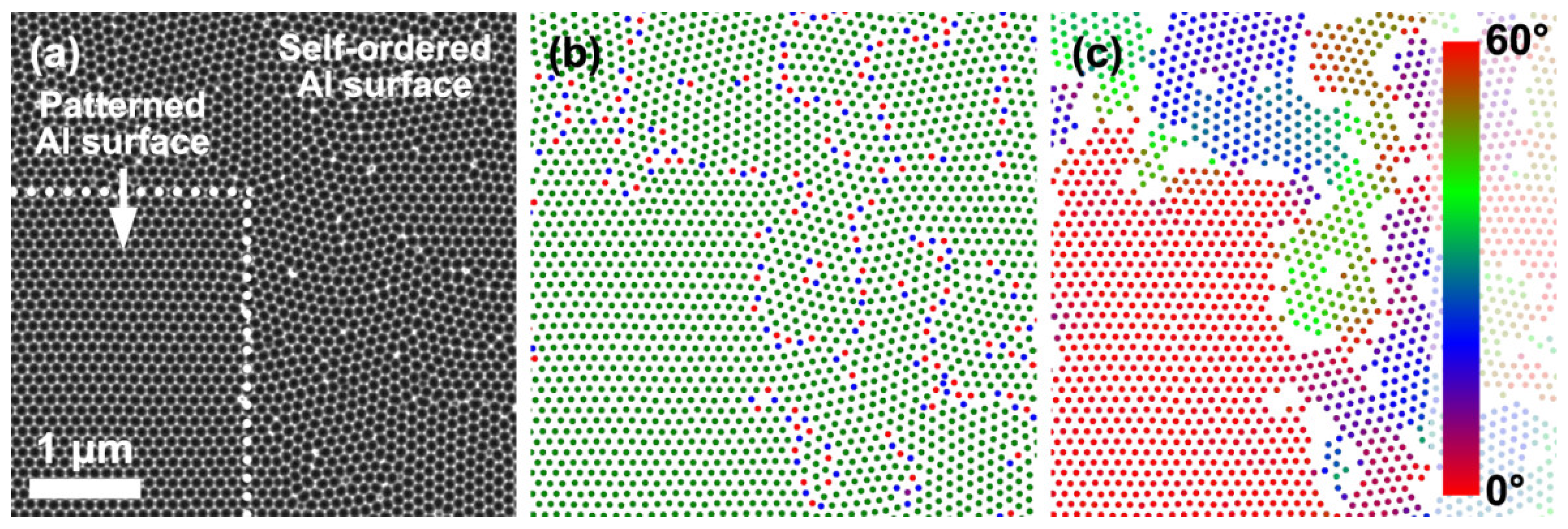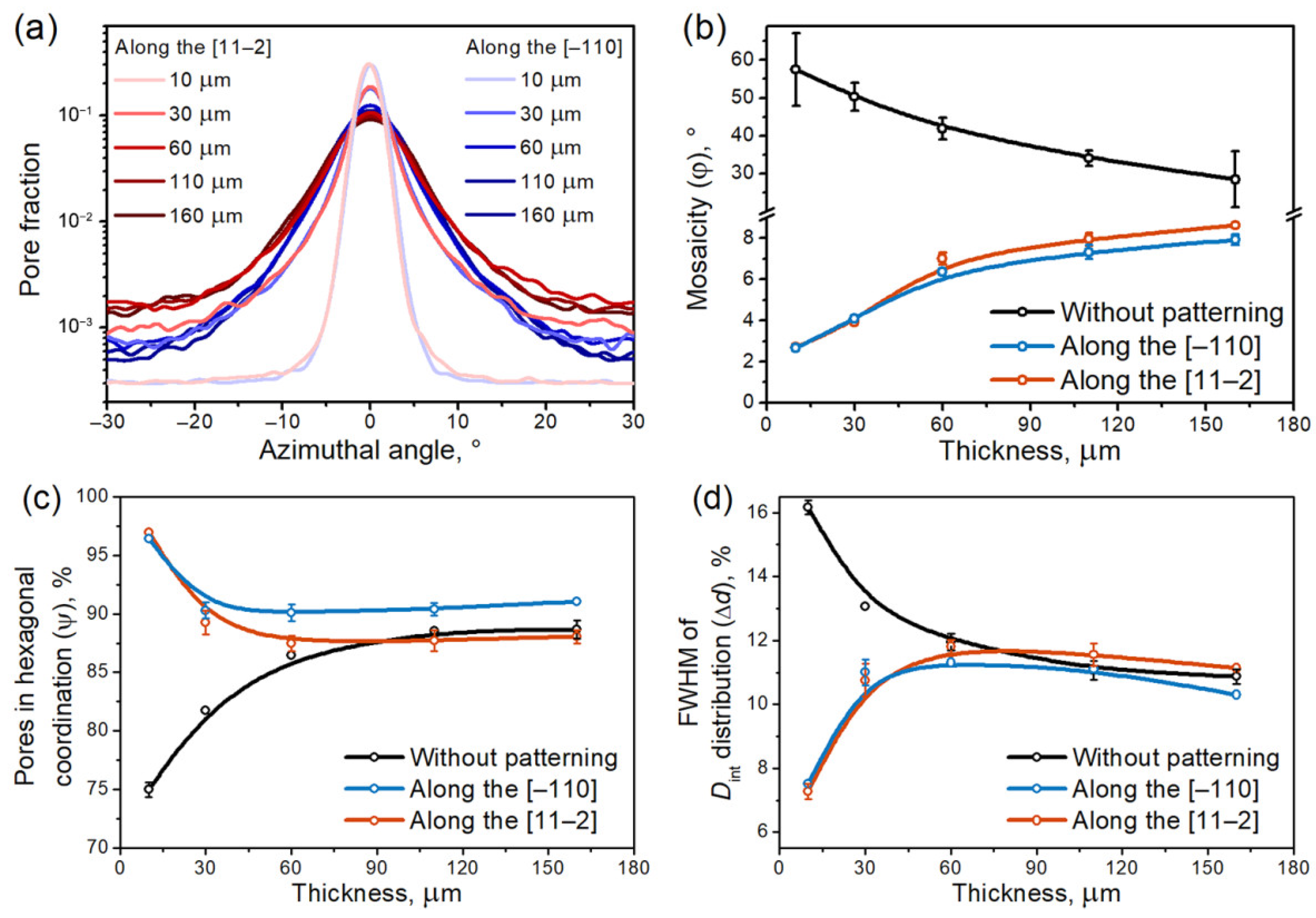Pore Ordering in Anodic Aluminum Oxide: Interplay between the Pattern of Pore Nuclei and the Crystallographic Orientation of Aluminum
Abstract
:1. Introduction
2. Materials and Methods
3. Results and Discussion
4. Conclusions
Supplementary Materials
Author Contributions
Funding
Institutional Review Board Statement
Informed Consent Statement
Data Availability Statement
Acknowledgments
Conflicts of Interest
References
- Giles, G. Electrolytic Condenser or Electrolytic Valve. U.S. Patent 1,190,886, 11 July 1916. [Google Scholar]
- Bengough, G.D.; Stuart, J.M. Improved Process of Protecting Surfaces of Aluminium or Aluminium Alloys. UK Patent 223,994, 3 November 1924. [Google Scholar]
- Bengough, G.D.; Stuart, J.M. A Process of Producing a Coloured Surface on Aluminium or Aluminium Alloys. UK Patent 223,995, 3 November 1924. [Google Scholar]
- Lee, W.; Park, S.J. Porous anodic aluminum oxide: Anodization and templated synthesis of functional nanostructures. Chem. Rev. 2014, 114, 7487–7556. [Google Scholar] [CrossRef] [PubMed]
- Hourdakis, E.; Nassiopoulou, A.G. Recent advances in high density MIM capacitors using anodic aluminum oxide nanolayers. In Proceedings of the Physics, Chemistry and Applications of Nanostructures: Proceedings of International Conference Nanomeeting—2015, Minsk, Belarus, 26–29 May 2015; pp. 505–511. [Google Scholar] [CrossRef]
- Chen, W.; Wu, J.S.; Xia, X.H. Porous anodic alumina with continuously manipulated pore/cell size. ACS Nano 2008, 2, 959–965. [Google Scholar] [CrossRef] [PubMed]
- Resende, P.M.; Martin-Gonzalez, M. Sub-10 nm porous alumina templates to produce sub-10 nm nanowires. Microporous Mesoporous Mater. 2019, 284, 198–204. [Google Scholar] [CrossRef]
- Asoh, H.; Matsumoto, M.; Hashimoto, H. Effects of ethanol on the efficiency of the formation of anodic alumina in sulfuric acid. Surf. Coat. Technol. 2019, 378, 124947. [Google Scholar] [CrossRef]
- Akiya, S.; Kikuchi, T.; Natsui, S.; Sakaguchi, N.; Suzuki, R.O. Self-ordered porous alumina fabricated via phosphonic acid anodizing. Electrochim. Acta 2016, 190, 471–479. [Google Scholar] [CrossRef] [Green Version]
- Roslyakov, I.V.; Gordeeva, E.O.; Napolskii, K.S. Role of electrode reaction kinetics in self-ordering of porous anodic alumina. Electrochim. Acta 2017, 241, 362–369. [Google Scholar] [CrossRef]
- Roslyakov, I.V.; Koshkodaev, D.S.; Lebedev, V.A.; Napolskii, K.S. Porous anodic alumina films grown on Al(111) single crystals. J. Surf. Investig. X-ray Synchrotron Neutron Tech. 2019, 13, 955–961. [Google Scholar] [CrossRef]
- Zaraska, L.; Stepniowski, W.J.; Ciepiela, E.; Sulka, G.D. The effect of anodizing temperature on structural features and hexagonal arrangement of nanopores in alumina synthesized by two-step anodizing in oxalic acid. Thin Solid Film. 2013, 534, 155–161. [Google Scholar] [CrossRef]
- Leontiev, A.P.; Roslyakov, I.V.; Napolskii, K.S. Complex influence of temperature on oxalic acid anodizing of aluminium. Electrochim. Acta 2019, 319, 88–94. [Google Scholar] [CrossRef]
- Chernyakova, K.; Tzaneva, B.; Vrublevsky, I.; Videkov, V. Effect of aluminum anode temperature on growth rate and structure of nanoporous anodic alumina. J. Electrochem. Soc. 2020, 167, 103506. [Google Scholar] [CrossRef]
- Michalska-Domanska, M.; Stępniowski, W.Z.; Salerno, M. Effect of inter-electrode separation in the fabrication of nanoporous alumina by anodization. J. Electroanal. Chem. 2018, 823, 47–53. [Google Scholar] [CrossRef]
- Nowak-Stepniowska, A. A review of quantitative arrangement analysis methods applied to nanostructured anodic oxides characterization. Curr. Nanosci. 2015, 11, 581–592. [Google Scholar] [CrossRef]
- Stepniowski, W.J.; Zasada, D.; Bojar, Z. First step of anodization influences the final nanopore arrangement in anodized alumina. Surf. Coat. Technol. 2011, 206, 1416–1422. [Google Scholar] [CrossRef]
- Toccafondi, C.; Stepniowski, W.J.; Leoncini, M.; Salerno, M. Advanced morphological analysis of patterns of thin anodic porous alumina. Mater. Charact. 2014, 94, 26–36. [Google Scholar] [CrossRef]
- Roslyakov, I.V.; Koshkodaev, D.S.; Eliseev, A.A.; Hermida-Merino, D.; Petukhov, A.V.; Napolskii, K.S. Crystallography-induced correlations in pore ordering of anodic alumina films. J. Phys. Chem. C 2016, 120, 19698–19704. [Google Scholar] [CrossRef]
- Grigoriev, S.V.; Grigorieva, N.A.; Syromyatnikov, A.V.; Napolskii, K.S.; Eliseev, A.A.; Lukashin, A.V.; Tret’yakov, Y.D.; Eckerlebe, H. Two-dimensional spatially ordered Al2O3 systems: Small-angle neutron scattering investigation. JETP Lett. 2007, 85, 449–453. [Google Scholar] [CrossRef]
- Gordeeva, E.O.; Roslyakov, I.V.; Napolskii, K.S. Aluminium anodizing in selenic acid: Electrochemical behaviour, porous structure, and ordering regimes. Electrochim. Acta 2019, 307, 13–19. [Google Scholar] [CrossRef]
- Li, F.; Zhang, L.; Metzger, R.M. On the growth of highly ordered pores in anodized aluminum oxide. Chem. Mater. 1998, 10, 2470–2480. [Google Scholar] [CrossRef]
- Nielsch, K.; Choi, J.; Schwirn, K.; Wehrspohn, R.B.; Gosele, U. Self-ordering regimes of porous alumina: The 10% porosity rule. Nano Lett. 2002, 2, 677–680. [Google Scholar] [CrossRef]
- Napolskii, K.S.; Roslyakov, I.V.; Eliseev, A.A.; Petukhov, A.V.; Byelov, D.V.; Grigorieva, N.A.; Bouwman, W.G.; Lukashin, A.V.; Kvashnina, K.O.; Chumakov, A.P.; et al. Long-range ordering in anodic alumina films: A microradian X-ray diffraction study. J. Appl. Cryst. 2010, 43, 531–538. [Google Scholar] [CrossRef] [Green Version]
- Beck, G.; Petrikowski, K. Influence of the microstructure of the aluminum substrate on the regularity of the nanopore arrangement in an alumina layer formed by anodic oxidation. Surf. Coat. Technol. 2008, 202, 5084–5091. [Google Scholar] [CrossRef]
- Beck, G.; Bretzler, R. Regularity of nanopores in anodic alumina formed on orientated aluminium single-crystals. Mater. Chem. Phys. 2011, 128, 383–387. [Google Scholar] [CrossRef]
- Roslyakov, I.V.; Koshkodaev, D.S.; Eliseev, A.A.; Hermida-Merino, D.; Ivanov, V.K.; Petukhov, A.V.; Napolskii, K.S. Growth of porous anodic alumina on low-index surfaces of Al single crystals. J. Phys. Chem. C 2017, 121, 27511–27520. [Google Scholar] [CrossRef]
- Liu, C.Y.; Wang, Y.L. Creating anodic alumina nanochannel arrays with custom-made geometry. J. Chin. Chem. Soc. 2020, 67, 11–24. [Google Scholar] [CrossRef]
- Lee, W.; Ji, R.; Gosele, U.; Nielsch, K. Fast fabrication of long-range ordered porous alumina membranes by hard anodization. Nat. Mater. 2006, 5, 741–747. [Google Scholar] [CrossRef] [PubMed]
- Mikulskas, I.; Juodkazis, S.; Tomasiunas, R.; Dumas, J.G. Aluminum oxide photonic crystals grown by a new hybrid method. Adv. Mater. 2001, 13, 1574–1577. [Google Scholar] [CrossRef]
- Li, A.P.; Muller, F.; Gosele, U. Polycrystalline and monocrystalline pore arrays with large interpore distance in anodic alumina. Electrochem. Solid-State Lett. 2000, 3, 131–134. [Google Scholar] [CrossRef]
- Montero Moreno, J.M.; Waleczek, M.; Martens, S.; Zierold, R.; Gorlitz, D.; Vega Martinez, V.; Prida, V.M.; Nielsch, K. Constrained order in nanoporous alumina with high aspect ratio: Smart combination of interference lithography and hard anodization. Adv. Funct. Mater. 2014, 24, 1857–1863. [Google Scholar] [CrossRef]
- Liu, C.Y.; Datta, A.; Wang, Y.L. Ordered anodic alumina nanochannels on focused-ion-beam-prepatterned aluminum surfaces. Appl. Phys. Lett. 2001, 78, 120–122. [Google Scholar] [CrossRef]
- Liu, N.W.; Datta, A.; Liu, C.Y.; Wang, Y.L. High-speed focused-ion-beam patterning for guiding the growth of anodic alumina nanochannel arrays. Appl. Phys. Lett. 2003, 82, 1281–1283. [Google Scholar] [CrossRef]
- Asoh, H.; Nishio, K.; Nakao, M.; Tamamura, T.; Masuda, H. Conditions for fabrication of ideally ordered anodic porous alumina using pretextured Al. J. Electrochem. Soc. 2001, 148, B152–B156. [Google Scholar] [CrossRef]
- Han, H.; Park, S.J.; Jang, J.S.; Ryu, H.; Kim, K.J.; Baik, S.; Lee, W. In situ determination of the pore opening point during wet-chemical etching of the barrier layer of porous anodic aluminum oxide: Nonuniform impurity distribution in anodic oxide. ACS Appl. Mater. Interfaces 2013, 5, 3441–3448. [Google Scholar] [CrossRef]
- Napolskii, K.S.; Roslyakov, I.V.; Romanchuk, A.Y.; Kapitanova, O.O.; Mankevich, A.S.; Lebedev, V.A.; Eliseev, A.A. Origin of long-range orientational pore ordering in anodic films on aluminium. J. Mater. Chem. 2012, 22, 11922–11926. [Google Scholar] [CrossRef]
- Roslyakov, I.V.; Eliseev, A.A.; Yakovenko, E.V.; Zabelin, A.V.; Napolskii, K.S. Longitudinal pore alignment in anodic alumina films grown on polycrystalline metal substrates. J. Appl. Cryst. 2013, 46, 1705–1710. [Google Scholar] [CrossRef]
- Ng, C.K.Y.; Ngan, A.H.W. Precise control of nanohoneycomb ordering over anodic aluminum oxide of square centimeter areas. Chem. Mater. 2011, 23, 5264–5268. [Google Scholar] [CrossRef]
- Roslyakov, I.V.; Petukhov, D.I.; Napolskii, K.S. Permeability of anodic alumina membranes grown on low-index aluminium surfaces. Nanotechnology 2021, 32, 33LT01:1–33LT01:6. [Google Scholar] [CrossRef]
- Roslyakov, I.V.; Chumakov, A.P.; Eliseev, A.A.; Leontiev, A.P.; Konovalov, O.V.; Napolskii, K.S. Evolution of pore ordering during anodizing of aluminium single crystals: In situ small-angle X-ray scattering study. J. Phys. Chem. C 2021, 125, 9287–9295. [Google Scholar] [CrossRef]
- Roslyakov, I.V.; Kushnir, S.E.; Tsymbarenko, D.M.; Sapoletova, N.A.; Trusov, L.A.; Napolskii, K.S. New insight into anodizing aluminium with focused-ion-beam pre-patterning. Nanotechnology 2022. submitted. [Google Scholar]
- Schneider, C.A.; Rasband, W.S.; Eliceiri, K.W. NIH Image to ImageJ: 25 years of image analysis. Nat. Methods 2012, 9, 671–675. [Google Scholar] [CrossRef]
- Software for Analysis of Pore Ordering in Anodic Alumina. Available online: http://www.eng.fnm.msu.ru/en/software/ (accessed on 28 March 2022).




Publisher’s Note: MDPI stays neutral with regard to jurisdictional claims in published maps and institutional affiliations. |
© 2022 by the authors. Licensee MDPI, Basel, Switzerland. This article is an open access article distributed under the terms and conditions of the Creative Commons Attribution (CC BY) license (https://creativecommons.org/licenses/by/4.0/).
Share and Cite
Roslyakov, I.V.; Sotnichuk, S.V.; Kushnir, S.E.; Trusov, L.A.; Bozhev, I.V.; Napolskii, K.S. Pore Ordering in Anodic Aluminum Oxide: Interplay between the Pattern of Pore Nuclei and the Crystallographic Orientation of Aluminum. Nanomaterials 2022, 12, 1417. https://doi.org/10.3390/nano12091417
Roslyakov IV, Sotnichuk SV, Kushnir SE, Trusov LA, Bozhev IV, Napolskii KS. Pore Ordering in Anodic Aluminum Oxide: Interplay between the Pattern of Pore Nuclei and the Crystallographic Orientation of Aluminum. Nanomaterials. 2022; 12(9):1417. https://doi.org/10.3390/nano12091417
Chicago/Turabian StyleRoslyakov, Ilya V., Stepan V. Sotnichuk, Sergey E. Kushnir, Lev A. Trusov, Ivan V. Bozhev, and Kirill S. Napolskii. 2022. "Pore Ordering in Anodic Aluminum Oxide: Interplay between the Pattern of Pore Nuclei and the Crystallographic Orientation of Aluminum" Nanomaterials 12, no. 9: 1417. https://doi.org/10.3390/nano12091417
APA StyleRoslyakov, I. V., Sotnichuk, S. V., Kushnir, S. E., Trusov, L. A., Bozhev, I. V., & Napolskii, K. S. (2022). Pore Ordering in Anodic Aluminum Oxide: Interplay between the Pattern of Pore Nuclei and the Crystallographic Orientation of Aluminum. Nanomaterials, 12(9), 1417. https://doi.org/10.3390/nano12091417






